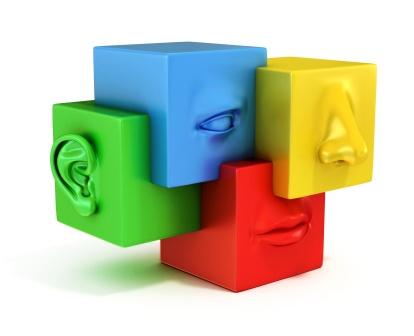Relation Between Doshas, Sense Organs And Perception
By Dr Raghuram Y.S. MD (Ay) & Dr Manasa, B.A.M.S
Sense organs and sensory perception are gifts of creation to mankind. We cannot imagine our life without involvement of these wonderful organs in accomplishment of all activities of our daily living.
Read –Indriya Pancha Panchaka: 5 Fives Of Sense Organs
Table of Contents
Introduction

Among all sense organs, eye is considered to be most important one according to Ayurveda. Isn’t it true? We are visual learners right from beginning of our evolution. Though we have used all our sense organs to enjoy, understand and react to this beautiful creation and events happening therein, we have learnt most things with aid of visual perception.
At same time, we cannot undermine importance of other sense organs, sensory perception and experience got by those organs in our lives. They are equally important.
Read – How Knowledge Is Gained Through Sense Organs?
Functions of all these sense organs are controlled predominantly by balanced vata. Thus, vata is the main dosha which aids proper perception of sensory objects. In process of sensory perception, other doshas i.e. pitta and kapha and their subtypes are also involved and aid vata to accomplish perception of organs of sense.
Read –Improper Use Of Sense Organs: A Neglected Cause For Diseases
Dosha – Sense organs
Association of doshas with sense organs and involvement of doshas in perception of sensory information
As already said, Vata is captain of sensory perception. Vata, when in state of balance enables sense organs to perceive their sense objects. Information is passed on to mind, judged by intellect and experienced by soul. Vata mediates entire equation of sensory perception. Vata also controls and motivates mind and keeps it intact and involved in sensory perception.
All sense organs and their functions i.e. perception of sense objects, processing, storage and reproduction of information related to objects is primarily controlled and monitored by vata. Subtypes of other doshas i.e. pitta and kapha are involved being localized in their respective sense organs.
Read – Jnana and Karma Indriyas: Organs Of Sense And Function
Doshas, eye and visual perception
Alochaka Pitta, a subtype of pitta is located in eye and is responsible for all functions of eye, especially perception of visual information by eyes. Among two types of alochaka pitta, drishti visheshaka alochaka pitta is involved in visual perception and understanding visual information.
Prana Vata, a subtype of vata causes opening and closing of eyes. Anyways this function is not related to visual perception. This function of prana vata protects eyes from external factors tending to damage eye like dust, smoke etc, blinking of eyelids and flushing off foreign materials entering eye by washing them in tear fluid produced by tear apparatus in eye. Prana Vata also helps in accommodation of vision to near and distant objects and aids alochaka pitta in proper perception of visual objects. It also monitors quantity of light entering eye.
Read – Eye Diseases Causes, Pathogenesis, Symptoms, Treatment, Herbs
Tarpaka Kapha, a subtype of kapha located in head, helps in nourishing, lubricating and protecting eyes by producing tears. It counteracts and balances hyperactivity of pitta and vata in eyes and protects them from excessive dryness and inflammation caused by vata and pitta respectively.
Doshas, ears and sound perception
Organ of perception of sound (ears) is one of chief sites of vata dosha. Thus Vata controls perception of sound being located in ears.
Tarpaka Kapha nourishes, lubricates and protects ears and balances hyperactivity of vata in ears.
Read – Tinnitus Causes, Ayurvedic Treatment, Herbs, Lifestyle Tips
Doshas, nose and smell perception
Organ of smell perception (nose) is one of chief sites of kapha dosha. Kapha controls perception of smell sensations being located in nose. Kapha forms mucus sheath in nose, produces mucus and acts as filter for dust and other foreign particles entering nose and thus protects respiratory passages. It moistens air entering nose.
Read – Nose Bleed: Ayurvedic Understanding, Treatment
Tarpaka kapha located in head nourishes, lubricates and protects nose.
Doshas, tongue and taste perception
Organ of perception of taste (tongue) is one of chief sites of kapha.
Bodhaka Kapha, one of the subtypes of kapha is seated in tongue. It helps in perception of taste and also helps differentiating between different tastes. It helps in moistening food particles which are masticated by teeth. This helps prana vata to push food down into food pipe and stomach because moist food can easily be propelled down. It also keeps mouth, lips and tongue moist, helps in articulation and maintenance of quality of voice and speech.
Tarpaka Kapha located in head nourishes, strengthens and supports sense organ of taste.
Read – Loss of appetite: Anorexia: Ayurvedic Understanding And Treatment
Doshas, skin and touch sensation
Organ of perception of touch sensations (skin) is one of the sites of vata. Vata controls mechanism of touch sensation and helps in getting knowledge of various types of touch sensations via skin.
Bhrajaka Pitta, one of subtypes of pitta is located in skin. It helps in maintaining temperature of body and imparts color, complexion and reflection to skin. It also helps in maintenance of health and immunity of skin.
Read – Sensitive Skin: Diet Changes, Ayurvedic Remedies, Medicines
Tarpaka Kapha located in head nourishes skin.
Click to Consult Dr Raghuram Y.S. MD (Ayu) – Email / Skype









